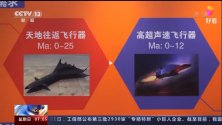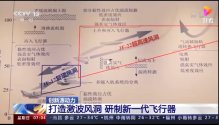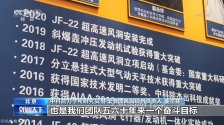You are using an out of date browser. It may not display this or other websites correctly.
You should upgrade or use an alternative browser.
You should upgrade or use an alternative browser.
Chinese Hypersonic Developments (HGVs/HCMs)
- Thread starter A.Man
- Start date
Strange ... was there a forum-software update, but I cannot see your attached media in the same way I cannot see mine here:
China's transport, tanker & heavy lift aircraft - esp. Y-20/YY-20
CCTV reporter visits a Y-20 airbase and takes a close-up look at the aircraft and the pilots' daily life.
www.sinodefenceforum.com
- Leading researcher reveals new facility capable of simulating flight at 30 times the speed of sound will be ready ‘soon’
- •Power produced by the JF-22 will be seven times more than the Hoover Dam in the US, almost as much as Three Gorges
Published: 8:30pm, 31 May, 2021
Updated: 9:11pm, 31 May, 2021

The existing JF-12 hypersonic wind tunnel in Beijing has about one-fifth of the power output of the new facility under construction. Photo: Handout
A Chinese physicist has said that a new wind tunnel in Beijing to be unveiled “soon” will put China decades ahead of the rest of the world in hypersonic technology.
Chinese Academy of Sciences researcher Han Guilai told an online lecture last week that the JF-22 wind tunnel, in Beijing’s Huairou district, was capable of simulating flights at up to 10km per second – 30 times the speed of sound. Together with an existing facility, also in Beijing, it would put China “about 20 to 30 years ahead” of the West.
China releases first images of Mars taken by Zhu Rong rover
Han, from China’s top hypersonic research agency the Institute of Mechanics, said the surface of an aeroplane travelling at such a speed could reach 10,000 degrees Celsius (18,032 Fahrenheit) – hot enough to break air molecules into atoms, even giving some of them an electric charge.“This air is no longer the air we breathe in,” said Han. “The flying vehicle we study is like swimming in mud.”
Han said the power produced by the JF-22 wind tunnel would reach 15 gigawatts – nearly 70 per cent of the installed capacity of the world’s largest hydropower station Three Gorges Dam in China’s southwestern Sichuan province, or more than seven times the Hoover Dam in Nevada.
China, along with other major countries, has made huge investments in the development of hypersonic flight technology, which could make it possible for air travellers to land anywhere in the world in one or two hours. It would also cut the cost of space launches by more than 90 per cent, potentially bringing space travel within popular reach.
As China and the US compete for global technology leadership, the race to bring hypersonic flight to life has intensified.
Aerion, a private company developing hypersonic passenger aircraft based in Nevada, folded this month due to financial and technical hurdles. Last month, a much anticipated hypersonic weapon test by the US Air Force ended in failure.
Hypervelocity experiments started in the West in the late 1940s, and US pilot William John Knight briefly reached Mach 6.7 in a rocket-powered X-15 test plane in the 1960s. Despite their early start, Western countries so far lack a combat-ready hypersonic weapon, while none of their missile defence systems could intercept such high-speed objects from China or Russia.
China has already deployed numerous types of hypersonic weapons in recent years, with the number of test flights conducted in one year equivalent to a decade of tests in the US.
Chinese hypersonic test flights have recorded unusually high success rates, with no reported crashes. In 2019, Chinese space authorities conducted a secret experiment of what is believed to be a prototype space plane that can take off or land at an ordinary airport. Researchers have also revealed details, in domestic scientific journals, of hypersonic engine designs unseen anywhere else in the world.
Part of China’s success in hypersonics is because of the unique technology used in its wind tunnels. Unlike facilities in other countries – which use mechanical compressors to generate high-speed air flow – the JF-22 uses chemical explosions.
When the tunnel fires up, its fuel burns at a speed 100 million times faster than a gas stove, generating shock waves similar to those encountered by air planes at hypervelocity in high altitudes. According to Han, each plane or weapon model “needs to take about 10,000 tests in the tunnel” before production.
LENS II, the most advanced wind tunnel in the US, has simulated flights up to Mach 7, with the simulation lasting 30 milliseconds. In contrast, the JF-22’s average runtime could reach 130 milliseconds, with a much higher top speed, Han said.
“Our experiment time is much longer than theirs, so the aircraft model can be larger than theirs, and the experiments can be more advanced than theirs. This determines our leading position in the world.”
Qian Xuesen, father of China’s rocket programme, coined the term “hypersonic” in a 1946 paper after he discovered that the behaviour of air flow followed completely different rules at five times faster than sound.
Qian “dug a big hole at the time, and now people from all over the world are jumping into the hole,” said Han, a fourth-generation researcher with the hypersonic research programme started by Qian 60 years ago.
Han could not be immediately reached for comment on Monday but a Shanghai-based hypersonic physicist, who asked not to be named because of the project’s sensitivity, confirmed the information in the lecture.
While the launch date of the JF-22 remains classified, it will work together with the JF-12, an older tunnel with about a fifth of the power output, to simulate flight conditions at both higher and lower altitudes where air densities were quite different, according to the researcher.
“There is a Chinese saying, it takes 10 years to sharpen a sword,” Han said. “We have spent 60 years sharpening two swords. And they are the best.”
China has always been frustratingly (but appropriately) quiet on scramjets apart from leaking some breakthroughs and new developments every few years since the mid 2000s (when I joined the forum). It makes sense for low speed hypersonics and makes one wonder what scramjet they're using on the DF-100 and the air breathing HGVs. Scramjets are relatively simple things though and a family friends niece who works in material research on thermal properties in particular have said in conversation back in early 2010s that a variety of suitable materials used in vehicles designed for within atmosphere travel have long been mastered. I would imagine conventional scramjet use is limited because it caps the speed of a HGV. There are probably better solutions for propulsion being developed.
With so many hypersonic wind tunnels and supercomputers, it only makes sense that China would limit use of scramjets but be able to develop the optimal designs for its high superonic/hypersonic vehicles.
With so many hypersonic wind tunnels and supercomputers, it only makes sense that China would limit use of scramjets but be able to develop the optimal designs for its high superonic/hypersonic vehicles.
Is China the only country on earth with loads of various types of mach 10 hypersonic wind tunnels? I recall the US only recently managed to build some mach 10+ wind tunnels of any real usefulness. The Chinese ones apparently (given released and hinted info from both sides) seem to have much longer duration (all measured in microseconds!) than the American ones.
China apparently also now has a mach 30 wind tunnel? Putting it well ahead in this department than the US if we are to assume the US reports and reveals the extent of their wind tunnel abilities lol ... obviously not an appropriate assumption. Nevertheless, a Mach 30 wind tunnel definitely helps develop HGVs. Oh and having all those exascale supercomputers in China don't hurt either
The wind tunnel invovled must be the or one of the mach 30 capable wind tunnels if researched vehicles are allegedly up to mach 25. The lovely thing about China is it doesn't quite have the same financing limitations the US has. Once China has a piece of technology, it isn't a matter of cost anymore. The state owns and finances it and if the things is good and useful, they mass produce it (relative to what it is)... rockets, 10KT+ ships, supercomputers ... mach 30 wind tunnels. With the US, the really exotic and high end stuff seem almost too precious to make in numbers.
China apparently also now has a mach 30 wind tunnel? Putting it well ahead in this department than the US if we are to assume the US reports and reveals the extent of their wind tunnel abilities lol ... obviously not an appropriate assumption. Nevertheless, a Mach 30 wind tunnel definitely helps develop HGVs. Oh and having all those exascale supercomputers in China don't hurt either
The wind tunnel invovled must be the or one of the mach 30 capable wind tunnels if researched vehicles are allegedly up to mach 25. The lovely thing about China is it doesn't quite have the same financing limitations the US has. Once China has a piece of technology, it isn't a matter of cost anymore. The state owns and finances it and if the things is good and useful, they mass produce it (relative to what it is)... rockets, 10KT+ ships, supercomputers ... mach 30 wind tunnels. With the US, the really exotic and high end stuff seem almost too precious to make in numbers.
Last edited:
Hendrik_2000
Lieutenant General
From Henri K blog
JF-22, reference of the hypersonic wind tunnel with pulsed detonation waves and high enthalpy (爆轰 驱动 超 高速 高 焓 激波 风洞), will be inaugurated by 2022. It allows to reproduce the flight conditions between 40 and 100km altitude and up to 10km / s in speed.
JF-22, reference of the hypersonic wind tunnel with pulsed detonation waves and high enthalpy (爆轰 驱动 超 高速 高 焓 激波 风洞), will be inaugurated by 2022. It allows to reproduce the flight conditions between 40 and 100km altitude and up to 10km / s in speed.
Skywatcher
Captain
Huh, is that another first stage configuration for the Tengyun?




